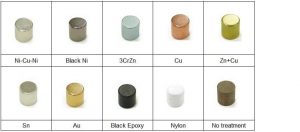Neodymium Magnet Coating
magnet coating is necessity
Neodymium magnet factory alway do not recommend making uncoated neodymium magnets. Because neodymoum magent contact with oxygen or water long time, the magnet will oxidized and decompose. So in order to against corrosion, make a coating on the magnets’s surface is necessary.

Types of neodymium magnet coating
NiCuNi : This most widely used plating consists of 3 layers of nickel-copper-nickel. The maximum operating temperature is approximately 220-240oC. NdFeB magnets used in motors, sensors, automotive applications, retention, generators, medical devices, thin film deposition processes and pumps mostly use NiCuNi. Because it has a lot of protective ability, and the processing cost is low.
Gold : Before adding this coating, we have to add the Ni-Cu-Ni coating at first. If you plate gold directly on the magnet, it won’t take long, and there will be quality problems. Gold plating is FDA (Food and Drug Administration) approved for use in the medical field. Because it will not harm the human body. But for very micro magnets, gold plating is not a good option.
Zinc : This is a lower cost coating and the magnets are not corroded in open air. It can be glued to steel, but a specially developed adhesive must be used. But since zinc is not as beautiful as nickel. The cost of Ni and Zn coating does not too much different unless the magnet is a big neodymium magnet.
Parylene : This coating is also FDA approved. Therefore, they are used for medical applications in the human body. The maximum operating temperature is approximately 150C. The molecular structure consists of cyclic hydrocarbon compounds with H, Cl and F substituents. According to the molecular structure, it is divided into different types: Parylene N, Parylene C, Parylene D and Parylene HT. For micro magnets with high tolerance requirements, Parylene is the best choice. Because the thickness of the coating can be precisely controlled.
Epoxy: This is a good coating. Good adhesion to steel if the magnet is bonded with a special magnetic adhesive. The maximum operating temperature is approximately 150C. Specially processed epoxy coating, can easily pass through salt spray for 200 hours. Therefore, it is widely used in the marine field, engine, sensor, consumer goods and automobile field.
Magnets injected into plastic :or also called overmoulded, its main characteristic is its excellent protection of the magnet against breakage, shocks and corrosion. The protective layer provides protection against water and salt. The maximum working temperature depends on the plastic used (acrylonitrile-butadiene-styrene).
Formed PTFE (Teflon): Like injected/plastic coating, it also provides excellent magnet protection against breakage, impact and corrosion. The magnet is protected against humidity, water and salt. The maximum working temperature is around 250°C. This coating is mainly used in the medical industries and in the food industry.
Rubber: The most common magnet with rubber coating in life is the pot magnet. This is because the rubber coating perfectly protects against breakage, impact and corrosion. The rubber material creates very good friction when sliding on steel.
Professional advice on how to protect your magnet
If NdFeB magnets are to work properly, continuously, and trouble-free, you need to ensure that you have the right coating. Different use conditions and applications determine which coating should be used. Our extensive experience in the magnetic field can provide customers with advice and solutions. If you have questions, don’t hesitate to contact us.
